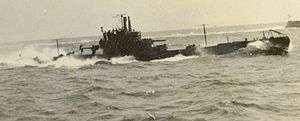Archimede-class submarine
The Archimede class were a group of four submarines built for the Regia Marina (Royal Italian Navy) in the early 1930s. The boats fought in the Spanish Civil War (under the Nationalist flag) and in World War II. Under Spanish colors, these boats were known as the General Mola class, and remained in service until 1959.
 Spanish Nationalist General Sanjurjo in 1938 | |
| Class overview | |
|---|---|
| Name: | Archimede class |
| Builders: | Cantieri navali Tosi di Taranto, Taranto |
| Operators: | |
| Built: | 1930–1934 |
| In service: | 1933–1958 |
| Completed: | 4 |
| Lost: | 1 |
| Retired: | 3 |
| General characteristics | |
| Type: | Submarine |
| Displacement: | |
| Length: | 70.5 m (231 ft 4 in) |
| Beam: | 6.87 m (22 ft 6 in) |
| Draft: | 4.12 m (13 ft 6 in) |
| Installed power: | |
| Propulsion: |
|
| Speed: |
|
| Range: |
|
| Test depth: | 90 m (300 ft) |
| Crew: | 55 |
| Armament: |
|
Design
The ships were designed by the firm Cavallini and were a partially double hulled design. They were an enlarged version of the Settembrini-class submarine with ballast tanks rearranged, greater range, fuel and torpedo capacity for ocean service. Like most of the later ocean-going submarines of the Italian navy, their deck armament consisting of two 100 mm guns was conceived to deal with armed merchantmen in surface combat.[1] That was the case of the Marcello-class submarine Comandante Cappellini, which between 5 and 14 January 1941 sank the British steamers Shakespear and Eumaeus off Cabo Verde after a protracted gunfire action.[2] Another example occurred when the Brin-class submarine Torricelli faced three British destroyers and a sloop while surfaced in the Red Sea. Before being sunk, the submarine hit the sloop and damaged the destroyer HMS Khartoum. Khartoum exploded near Perim after a torpedo fault set a fire that reached her magazines later that day.[1][3][4] They also mounted two 13.2 mm (0.52 in) anti-aircraft machine guns. The number of torpedoes was increased from 12 on the Settembrini class to 16.[6]
Boats
All boats were built by the shipyard of Franco Tosi at Taranto, between 1930 and 1934.
Torricelli and Archimede took part in the Spanish Civil war under the Italian flag since 1936, carrying out undercover operations. Eventually both submarines were secretly delivered to the Spanish rebel navy on April 1937.[7]
| Ship | namesake | Launched | Fate |
|---|---|---|---|
| Archimede/General Mola | Archimedes/Emilio Mola | 10 December 1933 | During the second half of 1936 she operated in Spanish waters covertly as Archimede. Transferred to the Spanish nationalist navy in April 1937, renamed General Mola. She sank the Republican transport Cabo Palos on 26 July 1937 and the Dutch freighter Hanna on 2 January 1938.[8] She also damaged beyond repair the Greek Lena on 30 March.[9] Stricken in 1959 |
| Galileo Ferraris | Galileo Ferraris | 11 August 1934 | Sunk 25 October 1941 off Gibraltar by the combined action of a RAF PBY-5A Catalina flying boat and the destroyer HMS Lamerton at the position 37°07′0″N 14°19′0″W |
| Galileo Galilei | Galileo Galilei | 19 March 1934 | On 16 June 1940, she sank the Norwegian tanker James Stove off Aden, in the Red Sea. Captured two days later by the British armed trawler HMS Moonstone. Commissioned into the Royal Navy as HMS X2, scrapped in 1946 |
| Evangelista Torricelli/General Sanjurjo | Evangelista Torricelli/Jose Sanjurjo | 27 March 1934 | She torpedoed and disabled the Republican Almirante Cervera-class cruiser Miguel de Cervantes in 1936, still under Italian flag as Torricelli. Transferred to the Spanish nationalist navy in April 1937, renamed General Sanjurjo. She sank the Republican troop transport Ciudad de Barcelona on 30 May 1937 and the British Endymion near the position 37°19′3″N 1°3′16″W on 21 January 1938.[10] Involved in an incident with HMS Torbay on 7 February 1943, during WWII, after the British submarine misidentified her as Italian.[11] Stricken in 1959 |
See also
References
Notes
- Bishop, Chris (2002). The Encyclopedia of Weapons of WWII: The Comprehensive Guide to Over 1,500 Weapons Systems, Including Tanks, Small Arms, Warplanes, Artillery, Ships, and Submarines. Sterling Publishing. p. 442. ISBN 1-58663-762-2.
- D'Adamo, Cristiano; Yost, Laura K. "R. Smg. Cappellini". The Italian Royal Navy. Retrieved 10 April 2013.
- Shrubb, R.; Sainsbury, A. (1979). The Royal Navy day by day. Centaur Press. p. 174. ISBN 0-900000-91-0.
- "HMS Khartoum (F45)". Uboat.net. Retrieved 10 April 2013.
- Miller, David (2002). Illustrated Directory of Submarines. Zenith. p. 180. ISBN 9780760313459.
- "Serie "General Mola"" (in Spanish). Pedro Fco. Curto Salvadó. Archived from the original on 5 May 2010. Retrieved 10 April 2013.
- "Submarinos". Fuerza naval (in Spanish) (84): 23. August 2009. Archived from the original on 2013-02-10. Retrieved 10 April 2013.
- González Etchegaray, Rafael (1977). La Marina Mercante y el tráfico marítimo en la Guerra Civil. San Martín. p. Appendix 2. ISBN 84-7140-150-9.
- Thomas, Hugh (1994). The Spanish Civil War. Simon & Schuster. p. 795. ISBN 0-671-75876-4.
- Western (16 July 2009). "ALERNAVIOS: "GENERAL SANJURJO"". ALERNAVIOS. Retrieved 2017-06-08.
Bibliography
- Bagnasco, Erminio (1977). Submarines of World War Two. Annapolis, Maryland: Naval Institute Press. ISBN 0-87021-962-6.
- Brescia, Maurizio (2012). Mussolini's Navy: A Reference Guide to the Regina Marina 1930–45. Annapolis, Maryland: Naval Institute Press. ISBN 978-1-59114-544-8.
- Chesneau, Roger, ed. (1980). Conway's All the World's Fighting Ships 1922–1946. London: Conway Maritime Press. ISBN 0-85177-146-7.
- Fraccaroli, Aldo (1968). Italian Warships of World War II. Shepperton, UK: Ian Allan. ISBN 0-7110-0002-6.
- Frank, Willard C., Jr. (1989). "Question 12/88". Warship International. XXVI (1): 95–97. ISSN 0043-0374.